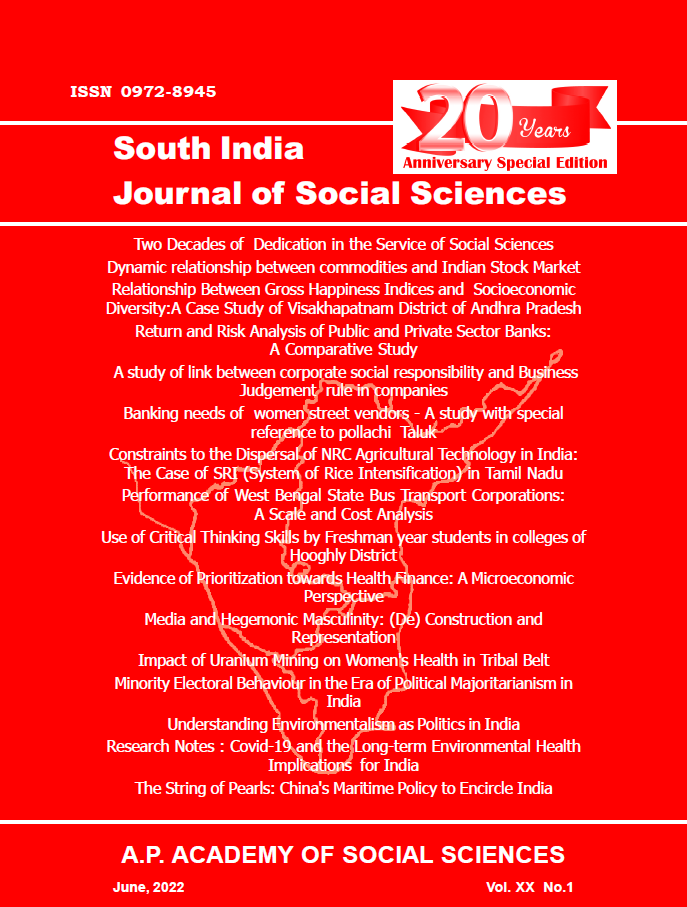Abstract
Banking sector plays a vital role in the development of the economy. Investing in banking securities is very common among investors, but the banking sector securities tend to be volatile in nature, so If the market value of the banking securities drops, the asset shrinks. Investment is an activity that commits funds in any financial or physical form with an expectation of receiving some return in the future. All investments are characterized by the expectation of return. In fact, investments are made with the primary objective of deriving a return. The expectation of a return may be from income (yield) as well as through capital appreciation. Capital appreciation is the difference between the sale price and purchase price of investment. The dividend or interest from the investment is yield. Different types of investments promise different rate of return. The expectation of return from an investment depends upon the nature of investment, maturity period, and market demand and so on. The longer the maturity period longer is the duration for which the investor parts with the value of investment. Hence, the investor would expect a higher return from such investments. Risk is inherent in any investment. Risk may relate to loss of capital, delay in repayment of capital, non-payment of interest or variability of returns. While some investments such as government securities and bank deposits are almost without risk, others are more risky. The risk of an investment is determined by the investment's maturity period, repayment capacity, and nature of return commitment. The longer the maturity period greater is the risk. When the expected time in which the investment has to be returned is a long duration, say ten years instead of five years, the uncertainty surrounding the return flow from investment increases. This uncertainty leads to a higher risk level for the investment with longer maturity rather than an investment with shorter maturity.
References
Dr.Meda Srinivasa Rao, Dr.Venkateswararao.Podile, Dr.Durgaprasad Navvula (2020), "Risk and Return Analysis of Selected Nifty Banking Stocks", European Journal of Molecular & Clinical Medicine, ISSN 2515-8260, Volume 7, Issue 4, pp. 1010- 1018.
Dr.Pravin Choudhary and Dr.Bhanu Sahu (2020), "A Comparative Study of Risk-Return Analysis of Public and Private Sector Banks", ELK Asia Pacific Journal of Finance, ISSN 2349-2325, Volume 11 Issue 3, pp.1-8.
Mehta VaniJoghee, Kanagatharani B, Gayathri S, Yazhini Devi R (2021), "A Study on Risk and Return Analysis of Selected Banking Securities", Turkish Journal of Computer and Mathematics Education, Vol.12 No. 11, pp.122- 127.
Ms. M. Giri Kumari and Prof. G.L. Narayanappa (2019), "Risk Return Analysis of Selected Banks Listed in Bombay Stock Exchange - A Comparative Study", EPRA International Journal of Economic and Business Review -Peer Reviewed Journal, e-ISSN: 2347 - 9671| p- ISSN: 2349 - 0187, Volume - 7, Issue- 8, pp.22-25.
Suresh A.S and SaiPrakash L (2018), "Study on Comparison of Risk-Return Analysis of Public and Private Sector Banks listed on Bank Nifty", Journal of Business Management and Economic Research, Vol.2, Issue.1, pp.1-8.
S. Kevin, "Security Analysis and Portfolio Management", PHI Publication, New Delhi.
. Punithavarty Pandian, "Security Analysis and Portfolio Management", Vikas Publication, New Delhi.
Websites
www.nseindia.com
www.moneycontrol.com

This work is licensed under a Creative Commons Attribution-NonCommercial-NoDerivatives 4.0 International License.
Copyright (c) 2022 SOUTH INDIA JOURNAL OF SOCIAL SCIENCES

